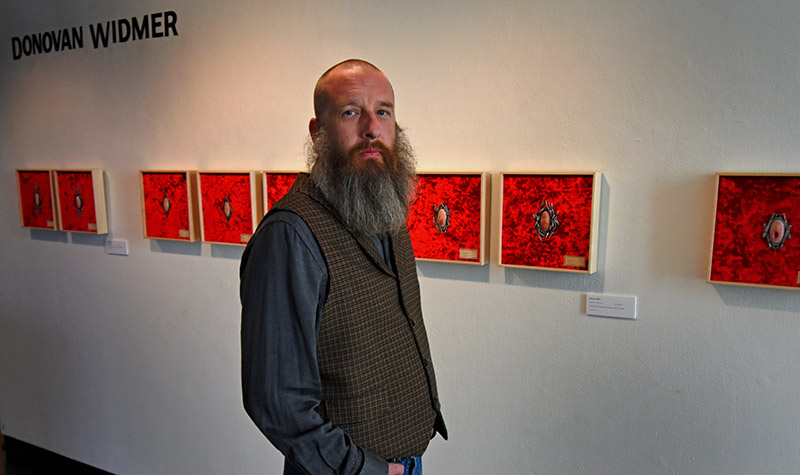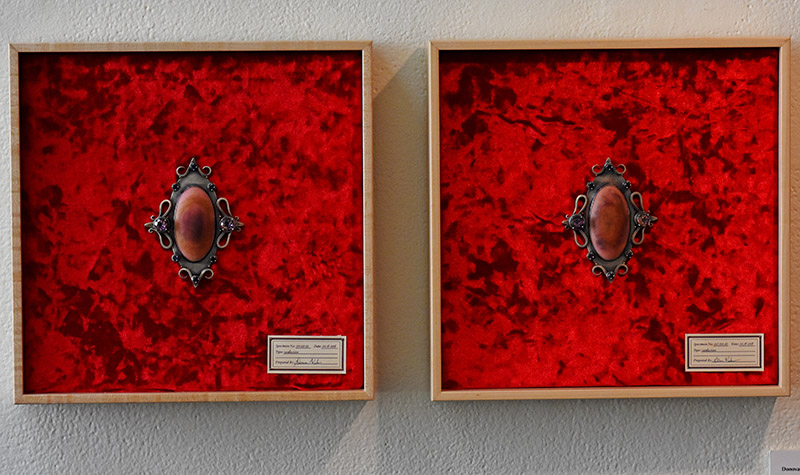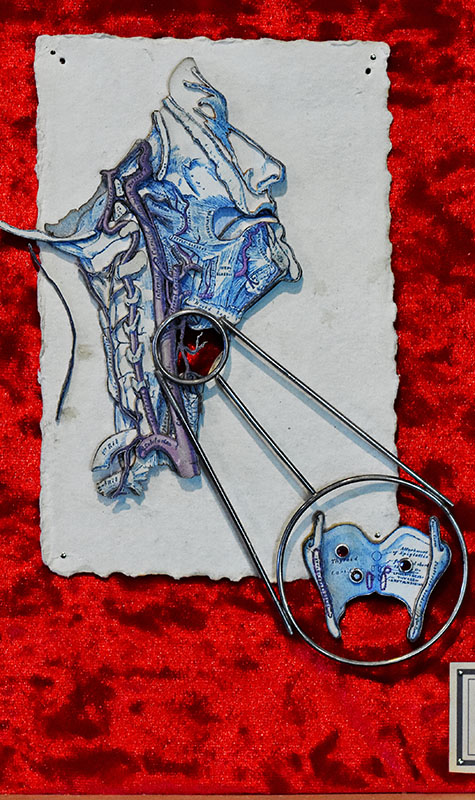08 Nov UND’s Donovan Widmer opens art exhibit at North Dakota Museum of Art

Donovan Widmer, chair of UND’s Department of Art & Design, explores the Western ideals of beauty in his new exhibit at the North Dakota Museum of Art. Photo by Patrick C. Miller/UND Today.
From a distance, the pinkish enameled brooches in Donovan Widmer’s art exhibit at the North Dakota Museum of Art resemble the Victorian Era cameos on which they’re patterned.
The exhibition, Ornamental Abjects, opened Oct. 27 at the museum on UND’s campus and runs through Dec. 15. It displays contemporary interpretations of 34 cameos made from glassy enamels combined with sterling silver fabricated elements and various precious gemstones. Widmer, who came to UND 15 years ago to teach metalsmithing, chairs the University’s Department of Art & Design.
The red crushed velvet background used in antique medical displays and the specimen tag on each framed piece provide clues that the artist might be interested in something other than recreating once-fashionable jewelry. A closer look reveals that individual brooches realistically portray a skin condition, such as a contusion, acne, ring worm or a fungal infection.
“If you think of the social role of jewelry, it’s personal enhancement to make yourself look more attractive,” Widmer explained. “What does it mean when, in this context, you’re wearing something that’s ugly? I certainly hope people walk away reflecting on their own notions of what is beautiful and how they determine it. How did you arrive at your conclusion?”

Widmer’s artwork resembles cameo jewelry from the 1920s, but each piece features a realistic representation of a skin condition rather than the more typical image of a person. The brooches are displayed on red velvet with a specimen tag, duplicating antique medical displays found in museums. Photo by Patrick C. Miller/UND Today.
Social stigmas
The skin conditions, according to Widmer, “are common maladies that affect a large portion of the population. In most cases these conditions are not contagious. However, the conditions often carry social stigmas.”

Donovan Widmer’s first artwork related to his latest exhibition, Ornamental Abjects, dealt with his experience with thyroid cancer in 1999. Photo by Patrick C. Miller/UND Today.
Every skin-colored oval is surrounded an intricate silver frame representing a tool, fungus, surgical instrument or other item associated with the medical condition. Each brooch required up to 150 hours of careful crafting by Widmer, an accomplished metalsmith and jeweler. He completed the pieces while on developmental leave in a garage at his home in East Grand Forks that serves as his studio.
Widmer has an answer for those who wonder why he would turn a symbol of wealth and beauty into something that might make some cringe.
“I like the idea of examining Western ideals of beauty, but it’s also about identity and shame,” Widmer noted. “Almost all of these skin conditions are non-contagious, but when we see somebody with one, we have this visceral, negative reaction – a bit of repulsion. Why do we see this as ugly?”
Although nobody can catch acne, psoriasis or eczema, Widmer said television commercials for products to treat these conditions often send the message that people who have them can’t lead normal lives and must hide the problem.
“There’s no reason to,” Widmer said. “Psoriasis isn’t contagious. You’re not going to catch it. So why do we see this as ugly? Why do we hide it? Why are there so many television commercials that basically publicly shame you if you have psoriasis or eczema? We all had acne. It’s nothing new, but there’s all this makeup and these different industries to fix it.”
Origins of the exhibit
There are other reasons Widmer has chosen to use his artistic talents to blend what some might consider an uncomfortable subject into an art museum exhibition. In the entryway to the second floor of the museum hangs one of his pieces that resembles, but is quite different from, the brooches. It’s titled “Papillary thyroid cancer” and dates back to 2008.
“In 1999, I was diagnosed with thyroid cancer,” Widmer noted. “It is the one and only piece I’ve ever done about that. I have always worried that if I make work about my experience with cancer, people do not see the artwork; they only see the artist and the cancer.”
He also cited the Mütter Museum of The College of Physicians in Philadelphia for influencing his interest in how medical oddities are displayed.
“It’s a fascinating museum and they have all these antique displays,” Widmer explained. “There’s an entire wall of wax faces with different skin conditions. That was a major inspiration.”
In addition, his wife bought him a book showing 1908 lithographs of skin conditions.
“That’s what gave me the idea to remake these things,” Widmer said. “I also wanted to keep that medical display strategy with the velvet background, the old 19th century tool kits and specimen tag descriptions.”

Widmer’s exhibition, Ornamental Abjects, opened on Oct. 27 at the North Dakota Museum of Art on the UND campus and runs through Dec. 15. Photo by Patrick C. Miller/UND Today.
Art as research
Widmer doesn’t see his exhibit as strictly artwork, but also as research.
“It just happens that this is my end product,” he said. “I start with an idea and I start with a thesis, like any other paper. My thesis is beauty through the lens of what is ugly – identity, shame. It’s how I’m presenting it for you to think about it and examine it.”
Widmer received his Bachelor of Fine Arts degree from Edinboro University of Pennsylvania and his Master of Fine Arts degree from the School of Art at Illinois State University. His work has been exhibited regionally, nationally and internationally in university, college and commercial galleries in New York, Pennsylvania, Texas, Oregon and California. His works have also been shown in London, Spain and Norway.


